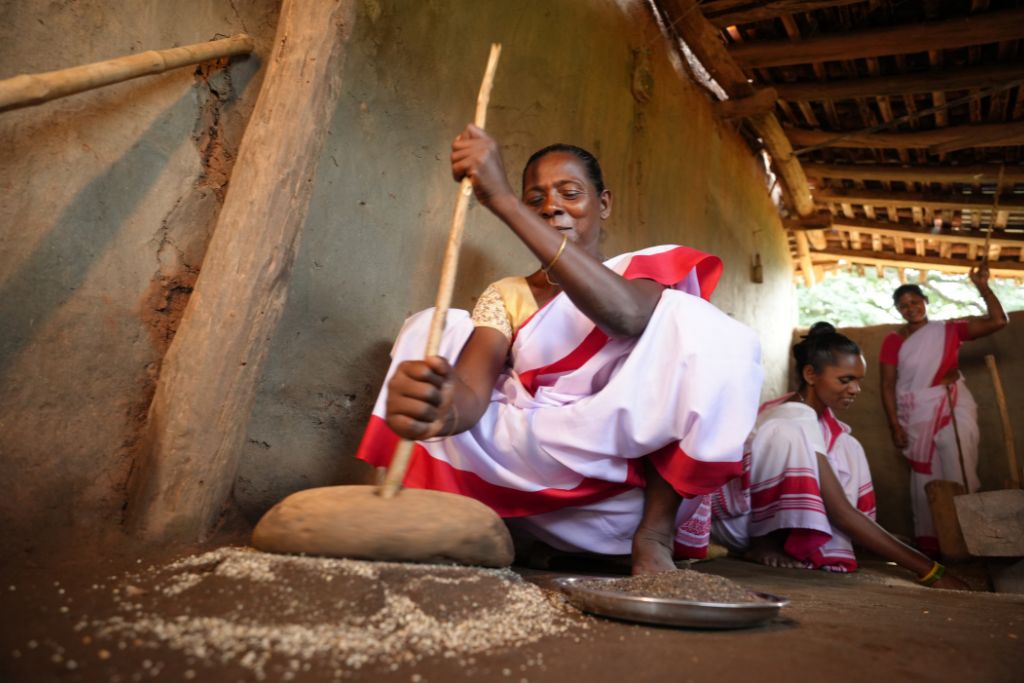
Munda women are safeguarding indigenous food systems
The Munda tribals of Chota Nagpur in Jharkhand are keeping their culture and identity alive by continuing to practice age-old traditions associated with agriculture.
The farmers belonging to the Munda community in Chota Nagpur tilling the land using the wooden plough or hul. Ploughing is a labour intensive process. There is an old adage that goes, ‘Baro mash, tero chas: Tabe karo, gora ash.’ Roughly translated it means, ‘Plough thirteen times in twelve months and then hope for good paddy.’ The ploughing season begins with the first shower of rain hitting the parched land, around June. (Photo Credit: Torpa Rural Development Society for Women)
India is a land of contrasts. Long stretches of paddy fields greet you in the north till you almost reach West Bengal in the east. And towards the south-west lies a hilly, jungle-clad plateau known as the Chota Nagpur. It is home to several generations of tribes, especially those belonging to the Munda community.
When the paddy is ripe for transplantation, standing knee-deep in the muddy waters, the farmers uproot the young shoots. They lay them aside in bundles that can be carried to be planted again elsewhere. Later, women make holes in the mud with their thumbs and deftly thrust in new shoots. During the harvest season, the reapers again wade through knee-deep waters to cut the crop with sickles. (Photo Credit: Torpa Rural Development Society for Women)
Beautiful plaiting methods are used to weave strips of Sanai or Sunnhemp (jute). The articulate hands of Munda women lend them several forms. Seen here is a floor mat or patiya. They also make moras, circular baskets, to store the threshed and cleaned paddy and safeguard them from pests. (Photo Credit: Torpa Rural Development Society for Women)
Instead of accepting payment, the lohar (blacksmith) usually claims a small share of the harvest for making sickles for the farmers. (Photo Credit: Torpa Rural Development Society for Women)
Another hand-crafted tool, the hasua knife, is also made by the lohar. It is used for scraping lac (resin) from the dried twig of a tree. (Photo Credit: Torpa Rural Development Society for Women)
Sup or winnowing pan is an integral part of paddy processing. The harvested paddy is bound in small bundles and carried to the khanyan (threshing floor). They are then placed in sups which are held above the head level to separate the grain from the chaff. When removed from storage, the rice grain is again shaken for any extra dust using the sup. (Photo Credit: Torpa Rural Development Society for Women)
To pound the dhaan or rice into a fine powder, a pounder called the dhekhi is used. It is swung up and down with the leg. The front of the dhekhi goes into a pit dug in the ground where a woman matches the timing of the pounder by dropping rice with her hand. Women with infants or smaller children sometimes have to balance a child on their waist while they pound the rice with one leg. (Photo Credit: Torpa Rural Development Society for Women)
As part of the ritual, women gather to sing pounding songs as they stomp the finger millet or madhwa into a fine powder with a heavy pounding pillar made from iron. (Photo Credit: Torpa Rural Development Society for Women)
The lead image on tops show the Munda women using different kitchen implements for different types of grain. For urad or black lentils, a room near the kitchen contains the jaata or stone hand-grinder that is used to press and remove the skin from the urad. (Photo Credit: Torpa Rural Development Society for Women)
Shveta Jadhav is a management consultant and works as a team lead at Torpa Rural Development Society for Women.







